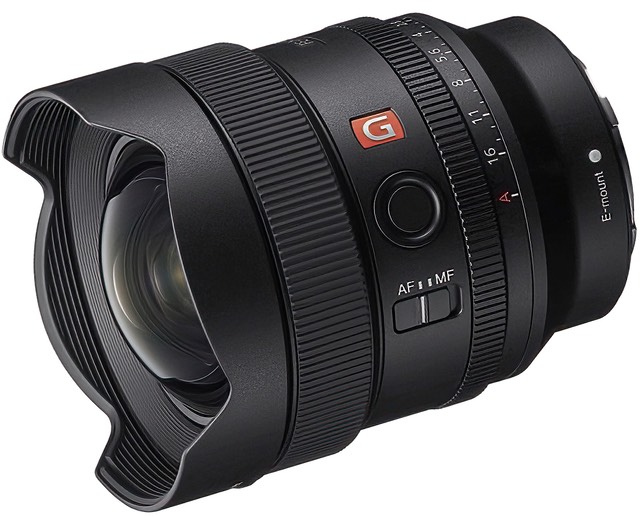
What is It?
Sony has been rounding out their lens lineup in admirable fashion. The f/1.8 line of full frame primes now consists of:
- 14mm f/1.8GM (this review)
- 20mm f/1.8G (that review)
- 35mm f/1.8
- 50mm f/1.8
- 85mm f/1.8
- 135mm f/1.8GM
We also have 24mm, 35mm, and 85mm f/1.4GM and 50mm f/1.2GM lenses to help round up the fast prime lineup. Some gaps might still said to exist (16mm, 18mm, 28mm, and 105mm), but overall it's unlikely that you can't find a solid basic set of three or more lenses that cover what you need covered. Most folk use fast primes to supplement their zoom set (whether f/2.8 or f/4), and we now have fast Sony primes that live in the wide-angle zoom, mid-range zoom, and even telephoto zoom range. Bravo.
As usual with the high-end lenses we have a fair deal of complexity in the optical formula (for a prime): 14 elements in 11 groups. We've also got two extreme aspherical, one regular aspherical, one Super ED, and two ED elements. So almost half the glass in the lens is "special" in some way. Nano AR II coating is also used in this lens, and the front element is fluorine coated for dust and water resistance. Sony's engineers are doing a lot of light ray manipulation in this design.
Up front we have a slip on lens cap and no filter ring. The lens hood is built in. At the back of the lens there's a slot for gel filters.
Size is surprisingly small, at just 4" (100mm) in length and 3.3" (88mm) in diameter. But all that glass does add up. The lens weighs just over a pound (460g). Even then, this is still the smallest and lightest fast 14mm we've seen. Heck, it's smaller and lighter than many 14mm f/2.8 lenses.
The left side of the lens (holding the camera) has one function button appropriately positioned for the left hand, and one switch that can move the lens from AF to manual focus operation.
The aperture ring is capable of being both clicked or de-clicked, controlled by a switch on the right side of the lens (as you're holding the camera). Third stop settings are clearly marked from f/1.8 to f/16, plus there's an A position for when you want to use body controls for aperture setting. The physical aperture is controlled by a 9-blade aperture diaphragm.
The focus ring is out front and easily found by touch, though it isn't as wide as some of Sony's focus rings. The ring is the usual fly-by-wire focus one you find in the E/FE mount. No focus marketings or DOF markings are present. Close focus distance is just a shade under one foot (0.25m). Sony is using dual linear motors to focus the lens, and focusing is internal (no lens extension).
The lens is sealed for dust and moisture resistance, ala all the GM lenses.
Price of the lens is US$1600, and is made in China.
Source of the reviewed lens: loaner from B&H
How's it Handle?
As usual with primes, there's not a lot to write about. The fly-by-wire focus ring is smooth, as you'd expect, and much more dependent upon how the camera is set than anything about how the lens functions, at least in terms of performance and accuracy.
The aperture ring has very stiff third stop points when set to clicked. It's physical difficult to move out of the A position, which is good. De-clicked the ring is smooth, but it will make sound as you turn it (a faint scratching type sound typical of mechanical rings).
The lens handles well on the A7 bodies, though there is a "clunk" sound that happens when you tilt the unit when it's powered off (likely from declutching the focus elements).
How's it Perform?
Sharpness: In the center, this lens is simply excellent, and I'd probably say superb. That's true wide open, it's true at any aperture until diffraction starts taking away acuity. Unfortunately, that super sharp center isn't particularly wide. At the APS-C boundary the lens is only very good wide open, and you have to stop down to f/2.8 to reach what I'd call excellent. The corners lag significantly beyond that. They start out at good- and don't get to the top of my good range until f/5.6. On the high resolution Sony cameras, you're in diffraction territory beyond that aperture, so the corners never really "pull in" the way I'd like them to.
Some of this corner issue is a bit of field curvature, which is common with a lens this wide. And that field curvature seems to be show up mostly on flat objects at nearer focus distances. At near infinity, the lens is actually sharper in the corners than near. Thus, you can mitigate curvature by carefully choosing your distance, focus plane, and depth of field. However, with close "flat" subjects (e.g. some architectural) you can't always do that.

Dark green = excellent, Medium green = very good to excellent-, light blue/green = good to very good-. The wider the darker green areas stretch, the better the lens is corner to corner. (Yes, this is the same pattern as the 20mm f/1.8G, however achieving this level at 14mm is much more difficult to do in optical design.)
Coma is well handled, as is spherical aberration. Points tend to remain points, though some may be softer (e.g. corners).

Not the full frame as I've cropped off the top and bottom. You can see the linear distortion here, but when I examine the rock, doors, and windows at the left and right sides, I really don't see a lot of falloff in sharpness. The real falloff comes only in the corners. For landscape or architectural use I have no issues with detail going to the four edges of the frame, only what happens in the true corner, where you're near both the horizontal and vertical edge.
Chromatic aberration: Uncorrected, the lens has some clear lateral chromatic aberration, showing up through almost two pixels wide open on the 61mp A7R Mark IV. As with the 20mm, longitudinal CA is present, but at lower levels than I'd expect from a fast lens. Clearly Sony is correcting for that with the ED glass.
Vignetting: As I found with the 20mm, very strong vignetting wide open, at over 3 stops in the corners. This improves to about 2 stops as you close the aperture, but it does not improve beyond that without correction. Sony's corrections make the vignetting basically ignorable only at f/2.8 and beyond (at f/1.8 you'll still get close to 2 stops in the corners).
Linear Distortion: Clear barrel distortion when uncorrected, at about 1.5%. However, the barrel gets a little mustache type dip right near the extreme corners. Corrected with Sony's corrections, you get a little bit of a bend outer 10% of the lens.
Flare: Typical Sony green ghosts can appear with light sources in the frame, though they tend to be near the light source (most wide angle lenses throw the ghosting flare across the entire frame).
Bokeh: Bright rings that can be colored (CA), though I see minimal onion skinning (those aspherical elements must be really polished well). Both diaphragm asymmetry and some cut off (not really cats eye) in the corners can be a little distracting. However, overall, for a wide angle lens the bokeh is generally okay.
Final Words
I was hoping for a bit more corner capability at maximum aperture, specifically for astrophotography. The lens is clearly usable for that, as there's little coma or spherical aberration contributions, and near infinity the field curvature doesn't seem to be an issue. Actually, it turns out that lateral chromatic aberration proves to be more of a problem with astro work than the sharpness (and remember you need to turn off lens corrections on a Sony camera if you're using raw files in astro work, as the corrections have this nasty way of showing up as regular artifacts as you process images).
I've tried a lot of 14mm primes over the years. They've all fallen out of my bag pretty quickly as their optical flaws began to bother me. Heck, even the 14-24mm zooms seemed to produce better images than some of the primes I tried. The Sony 14mm f/1.8GM is the first such 14mm prime I've encountered that is changing my mind about fast, really wide primes. Sony's done an admirable job in not only balancing the optical job, but keeping the lens small and thus bag-space worthy. I'm a bit torn between whether the 14mm or the 20mm should be the wide angle fast prime in my bag, and I wasn't expecting that. I like wide, so I suspect the 14mm will win in the end.
One interesting aspect of this lens is how good it is for video. No need for distortion corrections, a de-clickable aperture ring, and a gimbal-worthy size and weight should be really attractive to videographers using the A7 models. With video, you often find you need a wider lens in tight spaces, and those spaces, if indoors, don't tend to be lit well. So yeah, I can see the video crowd eating up this lens.
Not everyone needs a lens this wide, and if you don't understand perspective, that's likely to be you. But if you do need the focal length and aperture, I can heartily recommend this new Sony prime.
Recommended (2022 to present)
Support this site by purchasing from the following advertiser:
